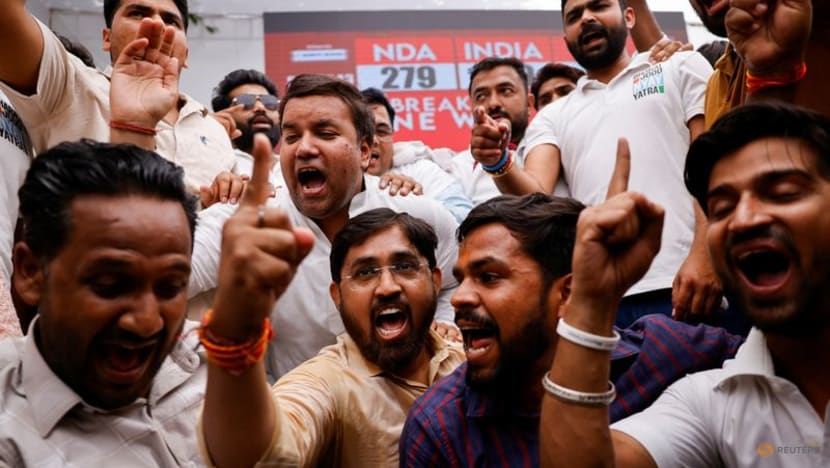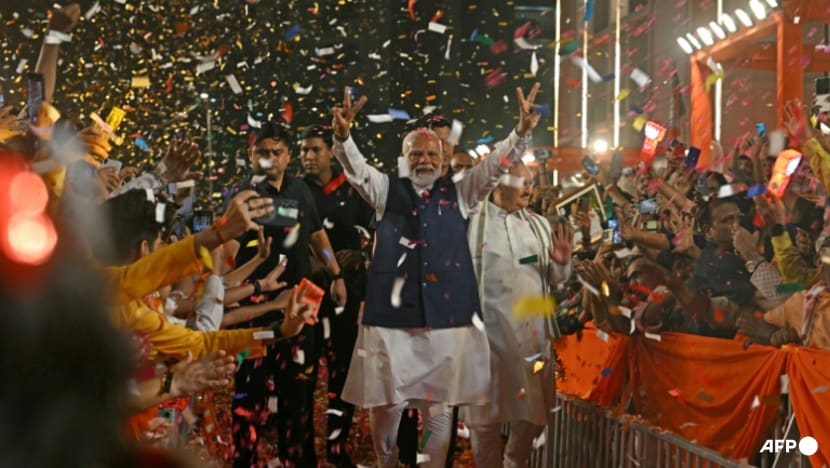CNA Explains: India’s ‘shock’ election result and the impact on Southeast Asia
Economic issues played a much bigger role in India’s mammoth general election than the ruling Bharatiya Janata Party hoped, said one expert.


This audio is generated by an AI tool.
India’s marathon general election drew to a close on Tuesday (Jun 4), with Prime Minister Narendra Modi’s ruling Bharatiya Janata Party (BJP) failing to win a parliamentary majority for the first time in a decade.
The shock result came as commentators and exit polls projected an overwhelming victory for Mr Modi, who will still enter a rare third term in office.
The election, which was conducted in seven phases over six weeks, concluded with more than 642 million votes cast in the world's largest democratic exercise.
What are the final results?
With the final vote count concluded, official results show that Mr Modi’s political alliance - known as the National Democratic Alliance (NDA) and led by BJP - has won enough seats needed to form the next government.
However, the BJP only secured 240 out of 543 parliamentary seats. This is much lower than the target of 400 seats that Mr Modi set during the election campaign, and the 303 seats that it won at the last polls five years ago.
The halfway mark is 272 seats.
Related:
The BJP also lost its national majority after major defeats in key states. After dominating Indian politics for a decade, it will need to rely on coalition allies to pass legislation in parliament.
Its current vote share at 36.6 per cent is marginally lower than at the last general election.
Meanwhile, the main opposition Congress party performed better than expected, defying several exit poll predictions.
It is set to take 99 seats, almost doubling its 2019 tally of 52. It also managed to end the BJP’s total dominance in Mr Modi’s home state of Gujarat, winning one seat out of 26 after coming up short in the 2014 and 2019 elections.
Congress leads the opposition INDIA coalition, which won 232 seats.
Why did BJP fail to win a large majority?
Analysts whom CNA spoke to pointed to voters being dissatisfied with issues like high unemployment, as well as the tactics used by the BJP to suppress the opposition.
Dr Irfan Nooruddin, professor of Indian politics at Georgetown University, said that economic issues played a much bigger role in this election than the BJP hoped.
“India’s economy is not quite as booming as a lot of the official numbers suggest. The official GDP (gross domestic product) numbers are very, very gaudy,” he told CNA938.
India faces a significant job crisis, he noted, with less than 10 per cent of its massive population of 1.4 billion people working in the formal sector.
Nearly 83 per cent of the country’s unemployed are its youth.
“Rural distress is very high and the majority of India still earns its income from agriculture, in some form or other, and don't do particularly well. Food insecurity has been increasing as inflation has gone up,” Dr Nooruddin said.
He added that while large pockets of tremendous wealth have emerged in India, that is not the ground reality for hundreds of millions of Indians.
“I think they … found the opposition alliance’s emphasis on social justice issues and economic issues more attractive, and felt maybe the BJP have gone a bit out of touch with their aspirations and needs,” he said.
Mr Neelanjan Sircar, senior fellow at the Centre for Policy Research in New Delhi, noted what had happened in the run-up to the election: the BJP using state institutions to dampen and harass the opposition.
Chief ministers were imprisoned, countless others had to deal with the tax authorities, and Congress’s bank accounts were frozen in February, leaving it unable to campaign properly.
“I think there was a larger understanding that … this may not be the most fair election, and (for) the voters, there was a narrative that this is the election to save democracy,” Mr Sircar told CNA’s Asia Now.
Dr Nooruddin said that a big surprise was how poorly the BJP performed in north India – particularly Uttar Pradesh state, the country’s most populous and the base of the party’s previous majority in the 2014 and 2019 elections.
“A lot of the rhetoric that the BJP had begun to use in this campaign, about anti-Muslim rhetoric and emphasis on religious symbolism, simply didn't resonate - including in places that were really the base constituency. So that was quite a surprise and quite a shocker for many observers,” Dr Nooruddin added.
“You can't distract hungry, poor people (by talking) about God and religion forever.”

How did exit polls get it so wrong?
The experts said it remains unclear how exit polls predicted a far too optimistic outcome for Mr Modi, projecting a landslide victory for him.
Dr Nooruddin said: “The exit poll industry remains relevant, but I think we have to do a much better job of discerning high-quality exit polls from a lot of the stuff that gets paraded on national television.”
He added that a large part of these polls are “super opaque”, with no clarity on the sample sizes and sampling strategy. Much of the attention was focused on nine polls commissioned by major news stations.
Dr Nooruddin advised people to diversify their sources, such as looking at the vernacular Hindi language media.
“They are often more accurate and closer to the ground,” he added.
What do the election results mean for Modi?
Mr Modi, a popular but divisive figure, created a cult of personality over the past decade. But analysts said his appeal may have peaked.
One way to read the results is that the Indian electorate has voted against the election being a referendum on a person, rather than a party, said Ms Prerna Singh, Mahatma Gandhi Associate Professor of political science and international studies at Brown University.
“The election was really fought on a cult of personality, a politics of hubris,” she told CNA’s Asia First.
Dr Nooruddin noted that Mr Modi, who is by far the country’s most popular politician, saw his vote margin in his own constituency drop by 60 per cent from about 400,000 to 150,000 votes.
Although this remains a convincing win, Dr Nooruddin said the much smaller margin of victory signals that something fundamentally has changed.
He added: “One other observation is that Modi is 73 years old. He himself said a while ago that no politician should be in office past the age of 75, but (whether) he intends to stick to his own mandate is unclear.”
In terms of Mr Modi’s Hindu nationalist agenda, Ms Singh said the BJP’s loss in the backyard of his signature Hindu temple was a “very important symbolic” one.
Mr Modi had inaugurated the controversial Ram temple, located in the northern town of Ayodhya, in January in what was seen as his trump card to retain power.
Ms Singh said BJP’s loss there signalled that Mr Modi’s anti-Muslim rhetoric reached a vitriolic pitch in the election campaign. The focus shifted towards questions of livelihood and the Constitution, which emerged as an unexpected and important rallying force for the electorate, especially in the countryside.
Nevertheless, Mr Modi clearly has the people’s backing and the mandate to get on with his economic policies, said Dr Amitendu Palit, senior research fellow and research lead in trade and Economics at the National University of Singapore (NUS)’s Institute of South Asian Studies.
“More people have actually voted for Modi than the others. The BJP might not have caught the maximum votes, but they have gotten the largest (number of) votes,” Dr Palit told CNA’s Asia Tonight.
How could this affect Southeast Asia and the world?
Analysts said that India’s core foreign policy interests and objectives will likely not change that much, as it seeks to retain influence in the region and strengthen strategic partnerships.
Mr Karthik Nachiappan, fellow at NUS’ Institute of South Asian Studies, told CNA’s Asia First that trade and investment will “get a lot of attention” and become an important policy going forward.
“That could mean more in Southeast Asia,” he added.
With India having become a key security partner and an actor in Southeast Asia in the past few years, there are hopes of further economic integration with the region, Mr Nachiappan said.
“I think India's general weakness in Southeast Asia has been economically embedding itself within the region. For various reasons, it hasn't been able to do that effectively,” he added.
India is not part of the Regional Comprehensive Economic Partnership – a free trade agreement among Asia-Pacific countries including Singapore, Malaysia, China, Japan and South Korea. Because of this, it has not been able to connect to regional value chains and economic structures, said Mr Nachiappan.
“Besides that, there are other issues that I think that could be also worth focusing on - issues like digital payments, fintech infrastructure,” he added.
Related:
How could India’s political landscape change?
Ms Singh said India faces a “very different era” compared with the last five years.
“In many ways, this is the shift to what had already been the norm before the rise of Prime Minister Modi. That is a return to coalition partners, a return to alliance politics,” she added.
Ms Singh said that the cult of personality politics, as well as the concentration of politics in New Delhi, will also dissipate.
At least two of the major coalition partners that Mr Modi must rely on – the Telugu Desam Party and Janata Dal (United) – have influence in South and East India respectively. This means regional politics will begin to play a more important role at the national level, Ms Singh added.
Mr Sircar from NUS said it will be “really unchartered territory” for Mr Modi, who “aggressively centralises power” and “does not play nice with coalition partners”.
He questioned whether Mr Modi would form new state institutions to keep his coalition together, like what he did against his political opponents.
On what role the opposition could play in the next government, Mr Sircar noted that citizens had to take to the streets to air their grievances against the BJP in the past decade, given that there was no parliamentary or electoral opposition for all intents and purposes.
“Perhaps now, people who have grievances can use formal parliamentary procedures again,” he added.
“So perhaps this is going to be a very, very good thing for parliamentary democracy.”















